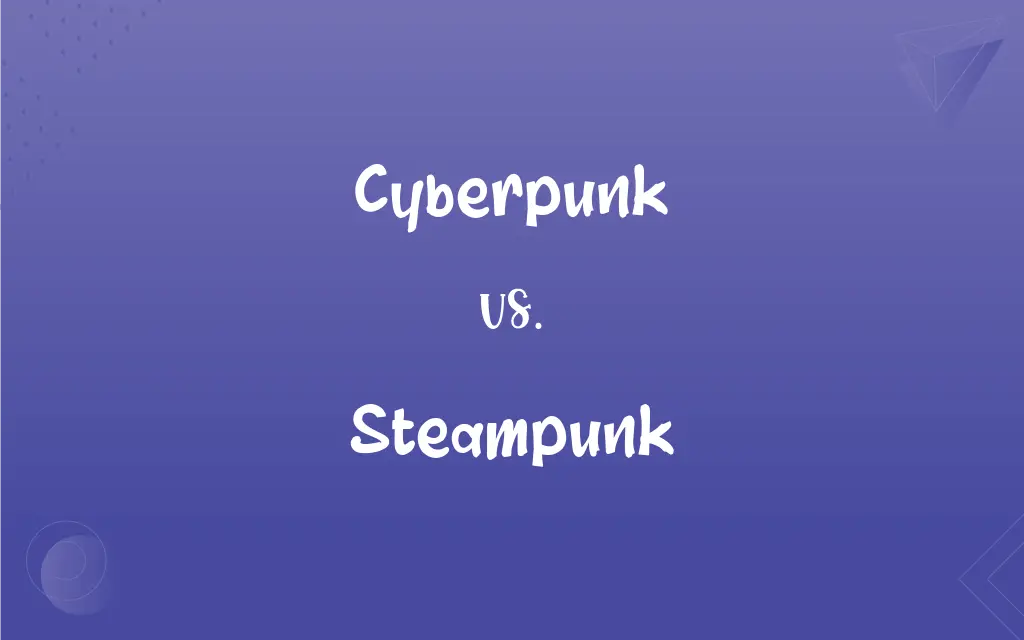Cyberpunk vs. Steampunk: What's the Difference?
Edited by Aimie Carlson || By Janet White || Updated on October 9, 2023
"Cyberpunk" envisions a high-tech, dystopian future, while "Steampunk" fuses Victorian-era aesthetics with retrofuturistic technology. Both imagine different technological timelines and societal contexts.

Key Differences
"Cyberpunk" often evokes images of a near-future world intertwined with advanced technology and cybernetics, frequently exploring themes of governmental and corporate oppression. Contrarily, "Steampunk" integrates technology and aesthetic designs inspired by 19th-century industrial steam-powered machinery, presenting an alternate historical timeline. Both genres reimagine technology and societal structures, albeit in diverging time frames and aesthetic approaches.
In a typical "Cyberpunk" setting, you might find characters interfacing with virtual realities, hacking computer systems, and navigating through heavily surveilled, urban landscapes. In contrast, a classic "Steampunk" scenario might transport you to a world where steam power is predominant, and characters sport Victorian attire, adorned with gears, goggles, and analog gadgets. The dissimilarity rests significantly in the eras and technological mediums each genre chooses to explore and visually represent.
"Cyberpunk" leans into notions of artificial intelligence, data networks, and often, a disheartening societal outlook, whereas "Steampunk" embraces an imaginative blend of historic and futuristic, intertwining advanced inventions with aged technology and materials. Each genre holds a distinctive cultural and visual charm, employing unique narrative tools to weave tales that reflect upon societal, technological, and ethical queries.
Despite "Cyberpunk" predominantly portraying a bleak, dystopian future wherein technology isn’t necessarily benevolent, "Steampunk" often revels in the explorative and adventurous, introducing brilliant inventors, and whimsical contraptions within a historical context. Both foster creative explorations of technology and society, yet through considerably contrasting lenses of optimism, aesthetic, and philosophical exploration.
While "Cyberpunk" stories often delve into concepts of identity, morality, and the societal implications of technological advancements, "Steampunk" tales might explore innovation, exploration, and the human spirit intertwined with retrofuturistic inventions. Each genre, through its distinct temporal and technological lens, crafts narratives that ponder humanity's relationship with technology, progress, and societal evolution.
ADVERTISEMENT
Comparison Chart
Central Technology
Advanced Cybernetics & AI
Steam Power & Analog Mechanisms
Aesthetic Era
Future Dystopian
Victorian Era & Retrofuturistic
Typical Setting
High-tech Urban Landscapes
Industrial Revolution-Inspired
Common Themes
Data, Surveillance, Oppression
Adventure, Invention, Exploration
Iconic Visuals
Neon, Data Streams, Cybernetics
Gears, Goggles, Victorian Attire
ADVERTISEMENT
Cyberpunk and Steampunk Definitions
Cyberpunk
Emphasizing cybernetic technology and artificial intelligence.
Cyberpunk narratives often feature rogue hackers and AI rebellion.
Steampunk
Typically set in an alternate historical timeline.
Steampunk might imagine a 19th-century world with advanced airships.
Cyberpunk
Depicting contrasts between low-life and high-tech.
Cyberpunk stories frequently showcase societal disparity amidst technological advancement.
Steampunk
A fusion of old-world charm and speculative fiction.
Steampunk blends the elegance of bygone eras with whimsical technological visions.
Cyberpunk
A genre envisioning dystopian, high-tech futures.
Blade Runner is a seminal film in the Cyberpunk genre.
Steampunk
A genre combining Victorian aesthetics with futuristic tech.
Steampunk novels often feature inventive gadgets in a historic setting.
Cyberpunk
Exploring themes of surveillance and corporate control.
In Cyberpunk worlds, omnipresent surveillance often quashes rebellion.
Steampunk
Focused on steam-powered machinery and analog tech.
Steampunk design incorporates gears, levers, and steam engines.
Cyberpunk
Often includes virtual realities and data realms.
Cyberpunk protagonists might navigate through complex virtual worlds.
Steampunk
Embraces themes of exploration and adventure.
Steampunk characters often embark on thrilling adventures with innovative devices.
Cyberpunk
Fast-paced science fiction involving futuristic computer-based societies.
Steampunk
Science fiction set in an alternate version of the historic past, especially 19th-century England, and involving advanced technologies usually based on steam power.
Cyberpunk
A subgenre of science fiction which focuses on computer or information technology and virtual reality juxtaposed with a degree of breakdown or radical change in the social order.
Steampunk
An aesthetic style inspired by steampunk fiction.
Cyberpunk
(countable) A cyberpunk character, a hacker punk, a high-tech low life.
The film “The Matrix” redefined what a cyberpunk looked like.
Steampunk
(uncountable) A subgenre of science fiction that depicts advanced technology combined with Victorian style and aesthetics, such as steam-powered machines and vehicles, visible gears and screws and people dressed in 19th-century attires. Category:en:Alternate history
Cyberpunk
(countable) A writer of cyberpunk fiction.
Steampunk
(countable) A writer of steampunk fiction.
Cyberpunk
A musical genre related to the punk movement that makes use of electronic sounds such as synthesizers.
Steampunk
A person cosplaying as a steampunk character.
Cyberpunk
A programmer who breaks into computer systems in order to steal or change or destroy information as a form of cyber-terrorism
Steampunk
(transitive) To depict in a steampunk manner.
Cyberpunk
A writer of science fiction set in a lawless subculture of an oppressive society dominated by computer technology
Cyberpunk
A genre of fast-paced science fiction involving oppressive futuristic compterized societies
FAQs
Is Cyberpunk typically set in the future?
Yes, often depicting dystopian, technologically advanced futures.
Is artificial intelligence a common theme in Cyberpunk?
Yes, AI and cybernetics are prevalent in Cyberpunk.
Is Cyberpunk optimistic about technology?
Typically, it’s cautious or skeptical regarding tech and society.
Does Steampunk always involve steam power?
Predominantly, with a focus on analog and mechanical tech.
Is Cyberpunk concerned with data and surveillance?
Yes, themes of data control and surveillance are common.
Are Cyberpunk narratives always dark?
Often, but with variations in narrative tone and outlook.
Does Steampunk incorporate real historical events?
Sometimes, but often with alternative, fantastical twists.
Can Steampunk include magic or fantasy elements?
Yes, it sometimes blends technology with fantastical elements.
Does Steampunk explore societal issues?
Yes, though often through a lens of adventure and invention.
Can Steampunk be set in the future?
Rarely, it mostly envisions an alternate past with advanced tech.
About Author
Written by
Janet WhiteJanet White has been an esteemed writer and blogger for Difference Wiki. Holding a Master's degree in Science and Medical Journalism from the prestigious Boston University, she has consistently demonstrated her expertise and passion for her field. When she's not immersed in her work, Janet relishes her time exercising, delving into a good book, and cherishing moments with friends and family.
Edited by
Aimie CarlsonAimie Carlson, holding a master's degree in English literature, is a fervent English language enthusiast. She lends her writing talents to Difference Wiki, a prominent website that specializes in comparisons, offering readers insightful analyses that both captivate and inform.































































